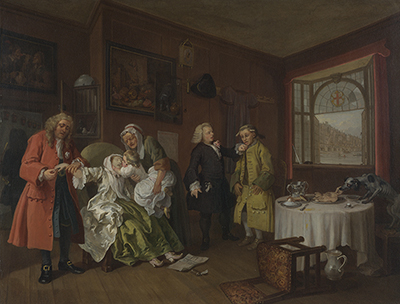The Lady's Death by William Hogarth is a final painting in a series of six that tells the moral story of the consequences of marrying into wealth rather than for love. The painting was created in 1743 and is an oil on canvas with dimensions 69.9 cm × 90.8 cm, which is in the National Gallery in London but is not on display.
It is hard to describe this painting without a background of the other paintings in the series. The Countess, the main character of the paintings, has lost everything and moved back to her father's poor house after her lover is charged with her husband's murder, she commits suicide by poison and the painting depicts her dying moments. One of the main features of the scene is the Countess's daughter kissing her mother, the daughter is obviously in poor health, wearing a sign that indicates syphillis, and wearing leg braces that indicate rickets or other serious mobility problems. The maid who holds the daughter up to kiss the mother also looks grief-stricken.
This is a very gloomy picture to contemplate, the Countess dying destitute in her father's parlour, with her only child who is also very sick kissing her goodbye. The father removes her wedding ring as all her other posessions are lost through the murder and suicide, the scene is one of mild chaos with a chair upturned, an empty poison bottle and letter on the floor, and a dog climbing up to steal from the table as the occupants of the room have their attention to the suicide; the father removing the ring which is all that is left of his shamed daughter's wealth, the child and maid grieving the Countess's death, the other two occupants in argument over the Countess obtaining the poison.
The room itself is dark, the walls lined with paintings, and a window loks out over the Thames. There is a clock on the wall and a hat and vest hung up. The table has scattered cutlery and dishes on a long white cloth. A jug stands by the table and one chair is occupied by the theiving dog while the other is overturned. The floor is bare boards, the window has stained glass and is curtained in pink. The men present wear long top coats, and the women wear long dresses and shawls, the child is wearing a white dress. The whole painting shows depression and death, hopelessness and loss.




